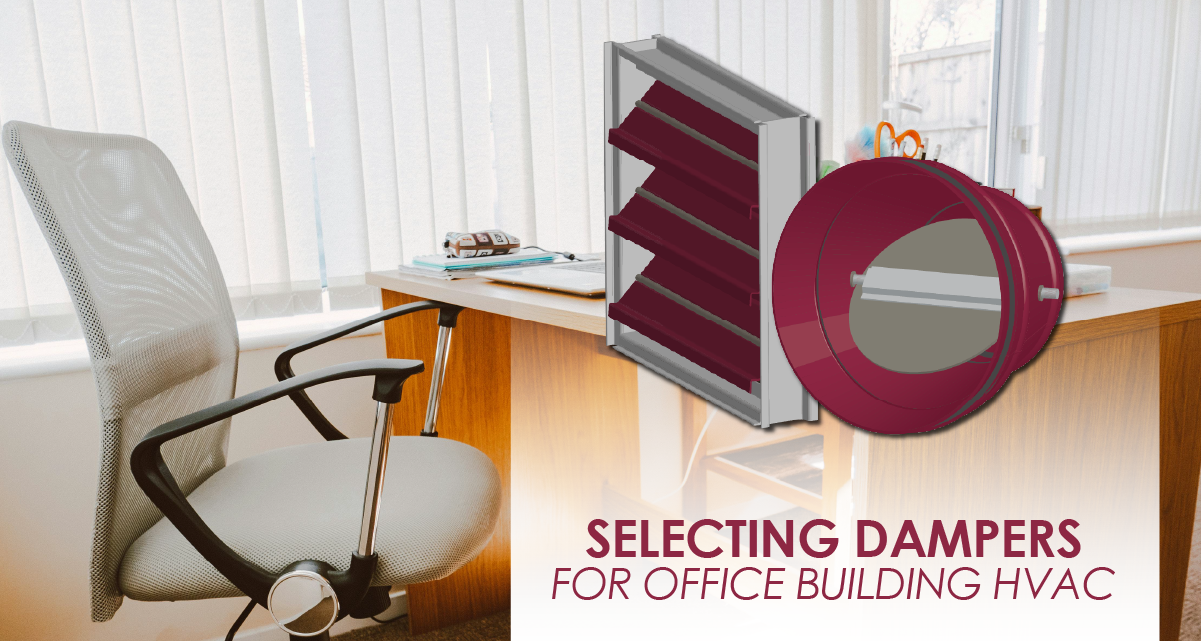Office buildings will have many zones that will have different airflow needs throughout the day. Keep air moving through your office with these dampers.
Airflow Control in Office Building HVAC
Comfort is a crucial factor in building design, especially in designing professional spaces. Well-designed spaces provide everything people need to focus on the task at hand. While lighting and color are key factors, nothing makes a space feel more welcoming than fresh, conditioned air.

As we discussed in “Zone Control Dampers”, you need dampers to direct that air from the HVAC unit to each part of the building. Office buildings will have many zones that will have different airflow needs throughout the day. You will need several types of dampers for an office building.
Let’s look at three damper types that you will need to keep air moving through your office space.
Control Dampers
Control dampers will be the most common type. These dampers act as gateways between each area of the building. Office buildings have many rooms, and each room should be comfortable throughout the day.
When the HVAC system starts up, control dampers will open to allow the air to pass to the rooms in need of air conditioning. The dampers will close when airflow stops, so that air can move to other parts of the building.

By default, a control damper will fully open to allow air through and fully close when airflow stops. Control dampers will open and close several times throughout the day, thanks to their actuators. “Fully open” means that the blades are at a flat 45-degree angle to the airflow. The blade profile should be flat with a few, if any, features along the profile. This will minimize the amount of pressure loss caused by the blades in the airstream.
Pressure loss can affect your system’s overall performance, if left unchecked. The fans in the system will need to spin faster to move air to the right place. This can put unnecessary strain on the system, on the power consumption and on the components themselves.
There are ways to manage pressure loss in your system, such as a balancing damper, so that air can always get to where it’s needed.
Balancing Dampers
Are there cold spots in a meeting room? Does one side of the building take longer to cool? It may have something to do with air pressure. Balancing dampers help the system maintain a specific air pressure at key points throughout the ductwork.
Balancing dampers look like control dampers. In “Control versus Balance,” we take a closer look at these two damper types to help you spot their differences.

These dampers maintain a specific blade angle throughout the day, regardless of whether air is flowing or not. This blade angle is typically determined by a technician, who measures air pressure in rooms connected to the duct.
When the right pressure is achieved, the technician will lock the blades in place. Balance dampers help alleviate issues with air pressure, like cold spots in rooms or phantom doors closing on their own. Balancing dampers are a powerful addition to larger systems that service many rooms across multiple floors.
Round Dampers and Transition Collars
Not all ducts will be square or rectangular. In fact, round spiral ductwork is more common in interior areas. Many designers like the aesthetic of exposed spiral ducts. They can provide an exposed and industrial look to the environment. They can also benefit airflow.

Spiral ducts will have curves in the duct, instead of sharp corners, allowing air to pass unhindered around corners. We recommend using round dampers for these ducts. Control dampers and balancing dampers can be round. You can also add a transition collar to a rectangular damper, if you find one that works best for your system.
Life Safety Dampers - Fire and Smoke Dampers
Life safety dampers don’t control or balance airflow, but they are an important part of your HVAC system. While other dampers help make occupants comfortable during the day, life safety dampers keep them safe during an emergency. “Life safety” is a category consisting of fire dampers, smoke dampers, and combination fire-smoke dampers.

These dampers are designed to close during an emergency. Their primary goal is to contain the spread of flames and noxious fumes. Each life safety damper is tied to a response device.
Fire dampers have a heat response device, like a fusible link or a sensotherm, which triggers the closure action. Smoke dampers are connected to smoke detectors in the duct, and close when the detector is tripped. Combination fire-smoke dampers will have both, to react to either situation. Life safety dampers are a required part of your HVAC system.
As you can see, your office building uses several damper types in its HVAC system. Each damper works to move air to where it’s needed, keeping everyone comfortable and safe.

Starting a new project? Consider adding control dampers from Arrow United Industries. We build every damper to meet your project's needs. Contact us today and let's work together on your next project.
For more on airflow dampers, check out these Newsstand articles:
- Round Dampers for Spiral Ducts
- Five Types of Dampers in HVAC
- Connecting Dampers and Multi-Panel Assemblies
- The Condenser - Product Spotlight: The 517-518 Series
.webp?width=91&height=70&name=MCDLG%20Logo%20(Resize).webp)





